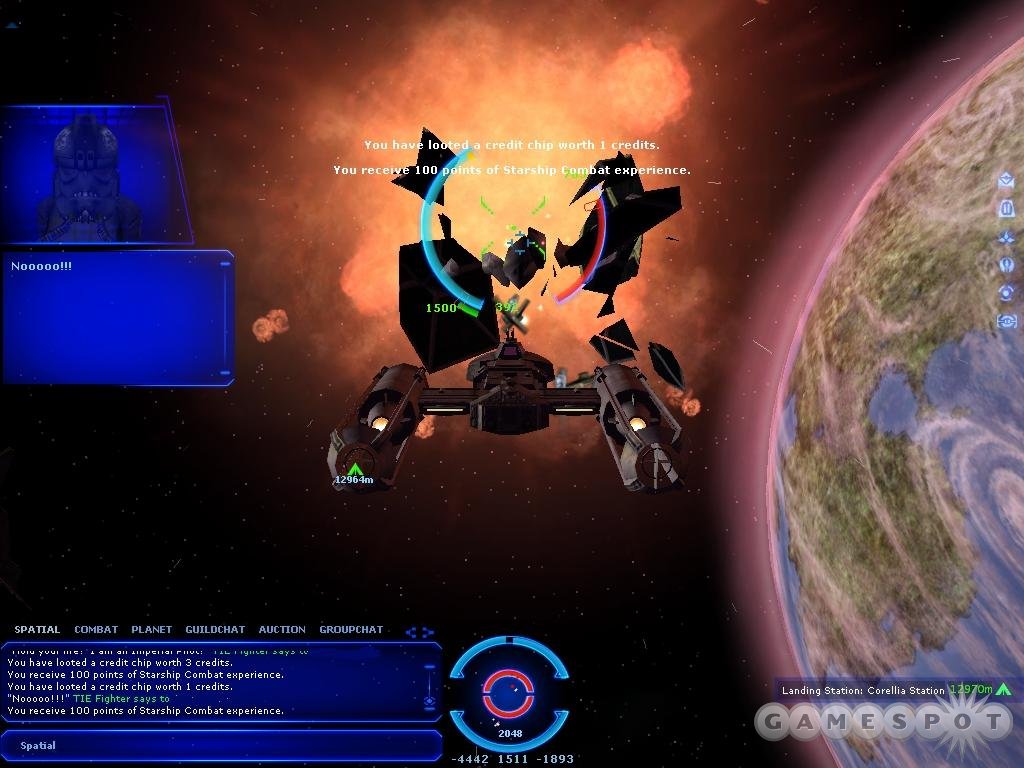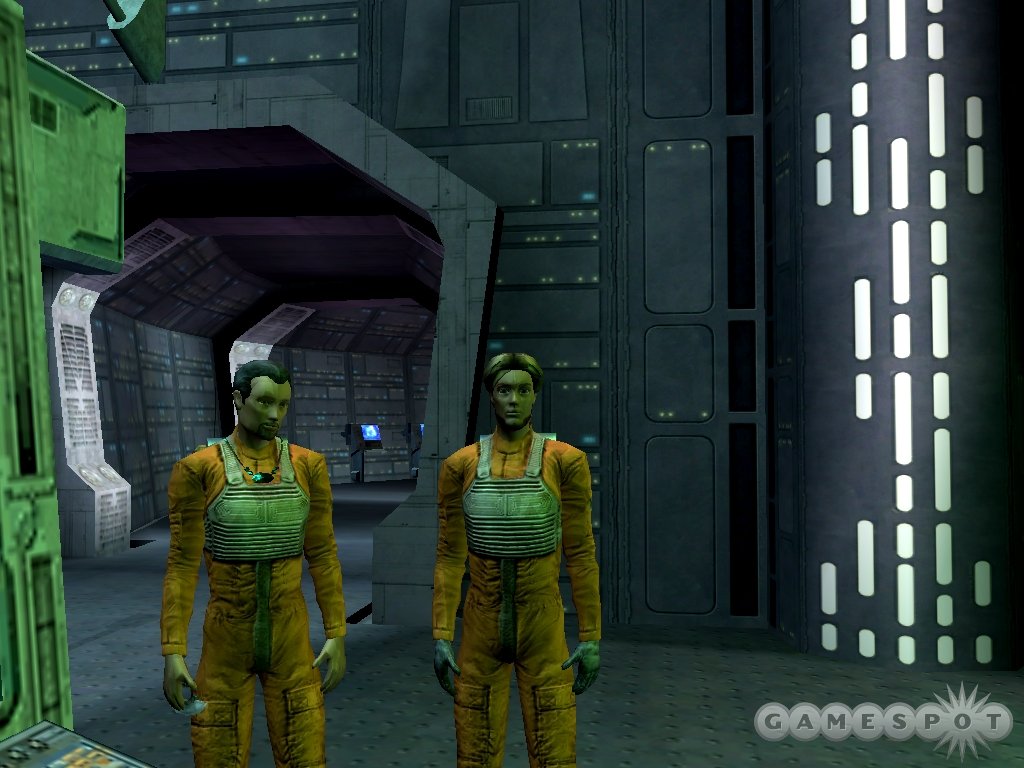Star Wars Galaxies: Jump to Lightspeed Final Hands-On
We don a Rebel pilot suit and head into space with the recently launched Star Wars Galaxies expansion.
When Sony Online Entertainment launched its Jump to Lightspeed expansion for Star Wars Galaxies earlier this week (a day before the game actually arrived in stores), we were among the first people to venture into space. Since we had a character affiliated with the Rebel Alliance, we felt compelled to opt for the Alliance starfighter pilot profession, although we could just have easily chosen to pursue a career as a freelance pilot. The Imperial Navy pilot position wasn't really an option, given our history with The Empire. We qualified for a 180-day veteran reward when we logged into Jump to Lightspeed for the first time, incidentally. We found that a Sorosuub luxury yacht, which can accommodate multiple players, can be furnished in the same way as a building, and you can walk around on it when you're in space. It doesn't have any weapons, though, so we haven't really used it much.

After deciding on our career path, we were allowed to choose one of three planets at which to start our Jump to Lightspeed training, and we were then told where to could find a non-player character trainer who would give us a starter ship (a Z-95 Headhunter in our case), offer us missions, and train us in new skills when we'd accumulated enough experience points. Veteran players of the original game will quickly notice that, unlike other professions in which you can climb four distinct skill ladders in any order you like, Jump to Lightspeed forces you to learn the bottom rung of every skill ladder before you're able to climb any of them. Given that each new skill you learn affords you access to better starships, better components, and additional combat actions, the system actually makes a lot of sense. If you were able to learn the pilot skills as you do in other professions, you could, for example, become certified to fly an X-Wing, but you would be unable to add anything but level 1 components to its chassis. You'd look pretty, but your ship would basically be useless in all but the tamest of combat situations.
In any case, the Z-95 Headhunter we started out with proved to be a tough little ship, and it wasn't long before we'd learned the first four skills (Alliance starfighter pilot 1-1-1-1) from our trainer on Tatooine. We were told that, since she had nothing left to teach us, we should relocate to Yavin IV where our ever-improving combat skills were required immediately. Unfortunately, the Z-95 Headhunter doesn't have a hyperdrive, nor can it be stowed neatly away as an owner's deed document (none of the starting spacecraft apparently can). Our only option was to locate a shipwright character that could make a Y-Wing (the first Rebel ship for which you get certified) for us, which wasn't easy given that we were one of very few people playing Jump to Lightspeed at that point. As is always the case in Star Wars Galaxies, the prices in the game's player-driven economy were all over the place on day one, and we saw ship blueprints selling (or at least being advertised) for anything from 6,000 credits to 250,000 credits.
Once you have a blueprint for the ship you're after, it'll cost you something in the region of 15,000 credits to have an NPC ship broker build a chassis for you, at which point you still won't be ready to take it for a test-fly. The chassis that you pay for is just that, a chassis, and before you can take it into space you'll need to add a number of vital components (most of which you'll already have looted from enemies with any luck) to the frame--a reactor and an engine, for example. Other components that make up a fully functional starship include boosters, weapons (one for each position if it's a multiperson craft--the Y-Wing can accommodate a second player in a gunner position, for example), a capacitor (to power the weapons), armor, shields, a countermeasure launcher, and a flight computer or droid (which requires a droid interface).
If you've read this far, then what you're probably really wondering is how the game performs once you're up in space, and we're pleased to report that we have not been disappointed thus far. The ship models are quite detailed (we can see our Y-Wing gunner's turret moving around as the player we're grouped with targets enemies, for example), the game plays perfectly well with a mouse and keyboard if you don't have a joystick, and, most importantly, it feels like Star Wars. Neither of the two galaxies we've looked in on to date appears to have an active player-versus-player scene up in space just yet, but there are more than enough computer-controlled enemies spawning to keep everybody busy. We've mostly been hunting TIE fighters and pirates working for Jabba the Hutt, but we have already seen a lot of other craft going about their business, including Rebel transports, cargo ships, Imperial shuttles and gunboats, and security forces escorting various convoys. The artificial intelligence for enemies in space seems a little limited at this point, especially in and around asteroid fields, but for the most part we've found our targets to be appropriately challenging.

Since a lot of the Rebels that we play with regularly aren't up in space yet, we've been spending a lot of our time flying solo, and more time than we'd like dying shortly after finding ourselves surrounded by enemies in ships more powerful than ours. We're getting the hang of hyperspacing out of situations like that, though, and were pleased to see that performing any kind of jump into hyperspace in Jump to Lightspeed takes a minute or so to execute while your ship's computer makes all of the necessary calculations--just like in the movies. When you die, you don't lose your ship, but you will need to spend a few thousand credits or so getting it repaired, and as usual, the next time you land you'll also need some attention from doctor and entertainer characters to heal your bodily wounds.
That's about all we have to say about Star Wars Galaxies: Jump to Lightspeed at this point, except to point out that the gameplay is being tweaked by the developers every day in these early stages (we're looting components from enemies noticeably less today than we were yesterday, for example), and that right now we're enjoying our time in Star Wars Galaxies a lot more than we had previously. Expect a full review of the Jump to Lightspeed expansion pack sometime next week.
Got a news tip or want to contact us directly? Email news@gamespot.com
Join the conversation